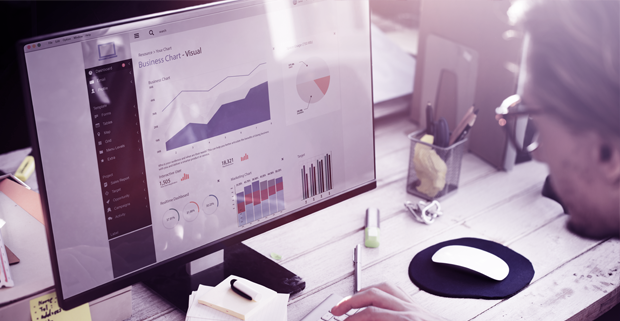
E-commerce
Gestão da cozinha: tecnologia reduz desperdícios e aumenta a lucratividade
Saiba como melhorar os processos e operações do seu restaurante usando as ferramentas certas para isso Um dos principais ingredientes

One of the great advantages e-commerce has over physical stores is the ability to measure each step taken by the user within the Website as well as the path that was covered to find the brand under online environment.
Understanding user insights regarding e-commerce, even if the customer would not proceed to the checkout, might help retailers in coming to a decision. Measuring the results and the in-depth analysis of consumer’s behavior allows taking actions to improve performance and target audience effective reach.
In this scenario, analytics capabilities have always brought benefits to virtual world due to the amount of available data, which as a result aroused a growing need to apply this technology to physical store. But here comes the tricky question: how? After all, POSs are a very distinguished e-commerce environment, resulting in more complex implementation of certain types of resources.
The good news is that technology already exists and can transform the Point of Sale into an extension of virtual channels, with the same capabilities and quality measurement.
But, before we talk about it, let’s learn a little more about what is analytics.
Analytics is the ability to use analytical data and systematic discoveries in order to create a more efficient decision-making process. Thus the analytical intelligence is used to improve business performance based on data forecasts provided.
As a result, consumer behavior approach tends to be broader and highly perceivable, providing resources predictability that is required for each strategic objective.
It is worth mention that, when it comes to analytics, data collection goes way beyond than only giving the amount of sales performed, or if most customers are men or women. Information, in that case, is much more specific and deep, analyzing issues such as time of observation for each product, heat maps, prospects, input / outputs, busy time and even the quantitative searching for items.
Another benefit provided by analytics is the fact of establishing the delivery of real time data, which provides to retailers a more efficient approach and management of resources.
Now: how to deploy a native tool from online environment to physical retail?
Today there are technologies used to such analysis in physical retail which are available in Brazil.
An increased usage of smartphones in the country plays a leading role in this scenario. According to 27th Annual Management Survey and Use of Information Technology in Enterprises sponsored by Fundação Getúlio Vargas São Paulo, the number of devices in use in Brazil will reach 168 million in 2016 only, a significant amount that the retailer can benefit from.
The use of smartphones has become behavioral, that is, in several generations the device is one of the main communication tools, as well as being an equipment that users virtually cannot live without. On that account, observing the use of smartphones at the point of sale is quite common for price inquiries or even to take a picture of the place.
Using this technology ever closer to consumers, combining it to a data analysis technology, you can create increasingly precise analysis tools for retail use. And the more data collected in different environments, more assertive the strategies are.
And how analytics works for physical retail?
Assessing consumer behavior in physical stores has always been a challenge for retailers. Get to know the workflow, the amount of visits, display window and corridors attractiveness, and mainly sales conversion rate was something virtually impossible and impractical to reach.
But today this is a resource that can be made available to physical stores with the help of some features such as Wi-Fi. If the consumer has a Wi-Fi enabled smartphone device with store presence that can be detected. You can identify the number of potential buyers, those who stopped at the window, how many entered the store, and who checked at the cashier.
When you look at the systems that come with all these data, the analysis becomes much deeper by including the number of catches, the average dwell time of each consumer in the store, the amount converted into sales and the average volume of sales inside the store.
In other words, you get metrics that can assist you in much more detailed strategies, as the correct window layout, POS merchandising actions effectiveness and other operations to increase average volume of sales.
New forms of consumers’ interaction can also be used from the use of this technology. For instance, when customer walks in the store and is his/her presence is detected, an offer can be sent to his/her mobile device, then surprising the customer positively and encouraging him/her to shop around.
How retailers and salespeople can benefit of the real time analysis capabilities inside the store?
All available resources and metrics are virtually useless if not properly used to stimulate sales.
This combining environment data to counter information creates countless possibilities. When analyzing real time information, for instance, if you notice that certain inventory items are not selling, you can increase the discounts on those items during times of greater customer flow at the store.
Attracting customers to your store with exclusive offers is also a way to leverage analytics information, such as promoting discounts on given items or birthday giveaways, or even on dates close to the payment of the last installment of a purchase.
As for salespeople, focusing on more assertive goals and demonstrating data that can be exploited, as well as the benefits in collecting customer information, can bring greater results. With a dashboard giving the average consumption of a customer entering the store, the employee can offer products based on consumer’s profiles, thus improving shopping experience, increasing sales and creating customer retention.
It is also interesting to know which are the busiest periods in stores and which days to demand more resources. Which is the period of greatest customer flow next to store, which showcase attracted more visitors and which are the best-selling products. Using this real time data, salespersons can prepare themselves to offer even more shopping experience to customers.
There are other metrics that can be used as a ranking of goals by salesperson to strengthen the relationship between Manager and employee, since the salesperson known exactly where he/she can improve with the aid of the performance improving resources.
How analytics can be used in a store chain?
One of the main concerns retailers face regarding store chains expansion is properly managing all stores with dedication.
For a good chain management performance, establishing guidelines is very important in sales, but to learn what actions to take and when to take can make things a lot simpler – and analytics is the resource to accomplish that.
As the stores are located in different places, consumer behavior can also be different, because it is affected by local culture. The same showcase arrangement might not work for all stores and customers flow can vary greatly from one region to another and at different times.
A store inventory can be filled with products, while others may be missing products, as well a given store may promote a much larger sale of a given item, but others may run the risk of having the same items stuck on shelf. These are some of the situations that the Manager can face exactly at the happening with the help of the analytics, thus ensuring each store productivity according to their characteristics. Based on this you can also set real time targets, after all, each day has a different turnover.
Analytics features work as the eyes of the store chain owner even if he or she is far away. He/she can check all products sold every minute without having to be on site, then review the performance of all sales for greater assertiveness in business managing.
Metrics, Data, Analysis! When checking and measuring sales, the retailer transforms insights into facts. If the physical retail was one of the main challenges to interpret consumer behavior at the POS, this is no longer a distant reality.